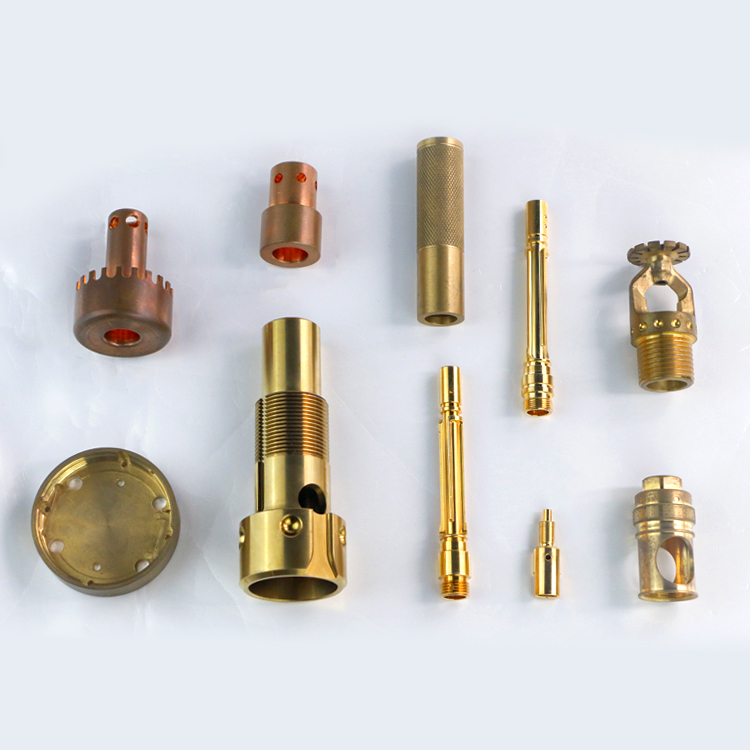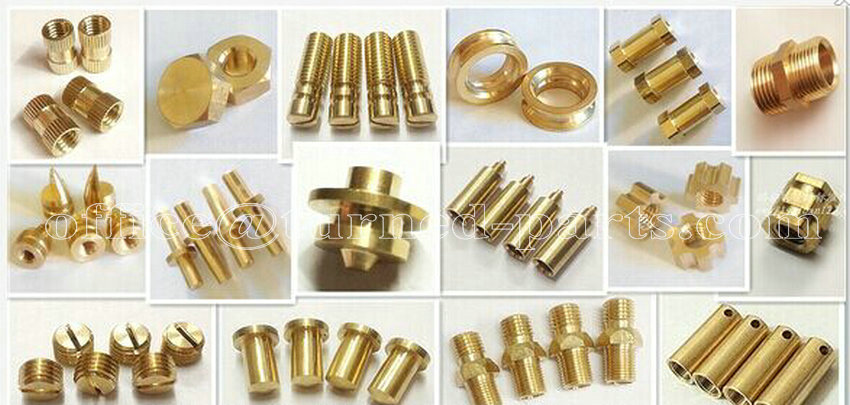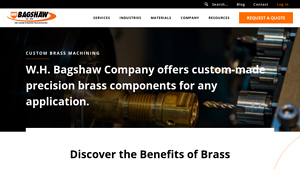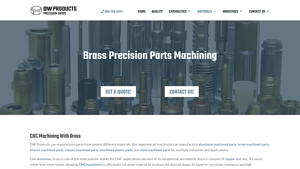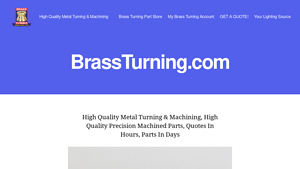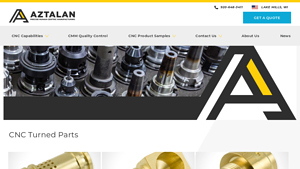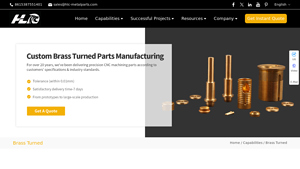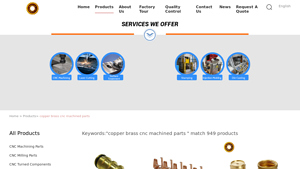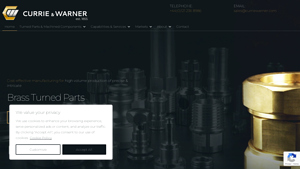Brass Cnc Turned Parts Guide: Type, Cost, Top List…
Introduction: Navigating the Global Market for brass cnc turned parts
In today’s competitive landscape, sourcing high-quality brass CNC turned parts presents a significant challenge for international B2B buyers. The complexities of navigating global supply chains, coupled with varying standards and regulations, can make the procurement process daunting. This comprehensive guide addresses these challenges by providing insights into the diverse types of brass CNC components available, their myriad applications, and essential criteria for supplier vetting.
Understanding the properties of different brass alloys, such as free machining and naval brass, is crucial for making informed purchasing decisions that align with specific project requirements. Additionally, we delve into cost considerations, production capabilities, and value-added services that can enhance your procurement strategy. This guide is tailored for B2B buyers from Africa, South America, the Middle East, and Europe—including key markets like Germany and Vietnam—empowering them to navigate the complexities of sourcing brass parts effectively.
By equipping you with the knowledge to assess quality, evaluate suppliers, and optimize costs, this resource aims to streamline your sourcing process. Whether your industry lies in electronics, medical, or general manufacturing, understanding the global market for brass CNC turned parts will enable you to make strategic decisions that drive success in your operations.
Understanding brass cnc turned parts Types and Variations
| Type Name | Key Distinguishing Features | Primary B2B Applications | Brief Pros & Cons for Buyers |
|---|---|---|---|
| Free Machining Brass | High machinability, contains lead for improved cutting ease | Electronics, automotive, plumbing | Pros: Excellent machinability, cost-effective. Cons: Lead content may limit use in certain applications. |
| Naval Brass | High corrosion resistance, includes tin for enhanced durability | Marine applications, oil and gas | Pros: Ideal for harsh environments, long-lasting. Cons: Higher cost compared to free machining brass. |
| Eco-Brass | Lead-free composition, environmentally friendly | Medical devices, food processing | Pros: Safe for health applications, compliant with regulations. Cons: May have lower machinability compared to leaded variants. |
| Brass Fittings | Specialized shapes for fluid transfer | Plumbing, HVAC systems | Pros: Customizable designs, robust performance. Cons: Potentially longer lead times for custom orders. |
| Precision Valves | Engineered for tight tolerances and reliability | Aerospace, automotive, industrial | Pros: High precision and reliability. Cons: Higher initial investment for precision manufacturing. |
What are the Characteristics and Suitability of Free Machining Brass?
Free machining brass, often recognized by its lead content, is designed for exceptional machinability. This alloy is ideal for high-volume production due to its ease of cutting, making it a preferred choice in the electronics and plumbing industries. When sourcing this material, buyers should consider the specific machining capabilities of their suppliers, as variations in lead content can affect performance in applications where lead exposure is a concern.
Why Choose Naval Brass for Marine Applications?
Naval brass stands out for its impressive corrosion resistance, making it particularly suitable for marine environments. With its tin content enhancing durability, this alloy is often used in the oil and gas sector as well. B2B buyers must evaluate the environmental conditions of their applications to ensure that naval brass is the right choice, as its higher cost may be justified by its longevity and performance in harsh settings.
What are the Benefits of Using Eco-Brass?
Eco-brass, a lead-free alternative, is gaining traction in industries where safety and environmental compliance are paramount, such as medical devices and food processing. While it may have slightly lower machinability compared to traditional brass, its health benefits and regulatory compliance make it an attractive option for manufacturers. Buyers should assess their specific application requirements, as the trade-off for safety may involve adjustments in machining processes.
How are Brass Fittings Customized for Specific Applications?
Brass fittings are often tailored to meet the unique needs of plumbing and HVAC systems. These parts can be designed in various shapes and sizes to ensure efficient fluid transfer. Buyers should consider the lead times for custom orders, as well as the supplier’s capabilities in producing specialized fittings. Ensuring a good fit for existing systems is crucial to avoid costly modifications during installation.
What Makes Precision Valves Essential in High-Stakes Industries?
Precision valves are critical components in sectors like aerospace and automotive, where reliability and tight tolerances are essential. These parts require advanced manufacturing techniques to ensure they meet stringent quality standards. Buyers need to weigh the initial investment against the long-term performance benefits, as the precision offered by these valves can significantly impact operational efficiency and safety in high-stakes applications.
Key Industrial Applications of brass cnc turned parts
| Industry/Sector | Specific Application of brass cnc turned parts | Value/Benefit for the Business | Key Sourcing Considerations for this Application |
|---|---|---|---|
| Electronics | Connectors and Terminals | High conductivity and reliability in electrical connections | Precision tolerances and compliance with international standards |
| Medical | Surgical Instruments and Components | Biocompatibility and corrosion resistance for safety | Certification requirements and quality assurance processes |
| Plumbing | Valves and Fittings | Durability and resistance to corrosion in water systems | Availability of lead-free options and adherence to local regulations |
| Aerospace | Aircraft Components | Lightweight yet strong materials for improved efficiency | Strict adherence to aerospace standards and traceability |
| Automotive | Engine Components and Fasteners | Enhanced performance and longevity of vehicle parts | Material certifications and ability to handle high-volume orders |
How Are Brass CNC Turned Parts Utilized in Electronics?
In the electronics industry, brass CNC turned parts are primarily used for manufacturing connectors and terminals. These components benefit from brass’s excellent electrical conductivity and low friction properties, ensuring reliable connections that are critical in electronic devices. For international buyers, especially in regions like Africa and South America, sourcing parts that meet specific electrical standards is essential. Additionally, ensuring that suppliers can provide parts with precision tolerances is crucial for maintaining device performance.
What Role Do Brass CNC Turned Parts Play in Medical Applications?
Brass CNC turned parts are vital in the medical field, particularly for surgical instruments and components. The material’s corrosion resistance and malleability allow for the production of intricate designs that can withstand sterilization processes. Buyers from the Middle East and Europe must prioritize sourcing from manufacturers that adhere to strict quality assurance protocols and hold relevant certifications, ensuring that all components are biocompatible and safe for patient use.
Why Are Brass CNC Turned Parts Important in Plumbing?
In plumbing, brass CNC turned parts, such as valves and fittings, are renowned for their durability and resistance to corrosion, making them ideal for water systems. The ability of brass to withstand various environmental conditions ensures long-lasting performance, which is a significant advantage for plumbing applications. Buyers should consider sourcing lead-free options to comply with local regulations, particularly in European markets where such standards are increasingly enforced.
How Are Brass CNC Turned Parts Beneficial in Aerospace?
In the aerospace sector, brass CNC turned parts are used for manufacturing lightweight yet strong components that contribute to the overall efficiency of aircraft. The high machinability of brass allows for the production of complex geometries required in various applications. International buyers should focus on suppliers that can guarantee compliance with stringent aerospace standards and provide traceability for all parts, ensuring safety and reliability in flight operations.
What Advantages Do Brass CNC Turned Parts Offer in Automotive Applications?
In the automotive industry, brass CNC turned parts are essential for producing engine components and fasteners that require exceptional strength and performance. The material’s ability to resist wear and fatigue enhances the longevity of vehicle parts, contributing to overall vehicle reliability. Buyers from diverse regions should evaluate suppliers based on their ability to fulfill high-volume orders while providing necessary material certifications to meet automotive industry standards.
3 Common User Pain Points for ‘brass cnc turned parts’ & Their Solutions
Scenario 1: Difficulty in Finding the Right Brass Alloy for Specific Applications
The Problem: B2B buyers often struggle to identify the right brass alloy for their specific applications. Each brass alloy has distinct properties, such as corrosion resistance, machinability, and thermal conductivity, which can significantly affect the performance of the final product. For instance, a buyer might need brass parts for a marine application but inadvertently choose a low-corrosion alloy that fails to withstand harsh saltwater environments, leading to product failure and increased costs.
The Solution: To effectively source the right brass alloy, buyers should start by clearly defining the operational environment and performance requirements of their application. Conducting a thorough needs assessment will help in identifying key properties such as corrosion resistance, strength, and machinability. Engaging with suppliers who specialize in brass machining can also provide valuable insights into the best alloy choices. It’s advisable to request sample parts made from various alloys to evaluate their performance under actual working conditions before placing large orders. Additionally, using alloy databases or consulting with metallurgical experts can help clarify the benefits of specific brass grades, ensuring that the selected alloy aligns with the intended use.
Scenario 2: Inconsistent Quality in Brass CNC Turned Parts
The Problem: Inconsistent quality of brass CNC turned parts can be a major pain point for buyers, particularly when working with multiple suppliers. Variations in manufacturing processes, quality control measures, and material sourcing can lead to discrepancies in dimensions, finishes, and overall performance. This inconsistency can result in production delays, increased rework costs, and ultimately, dissatisfied customers.
The Solution: To mitigate quality inconsistencies, buyers should prioritize suppliers with robust quality management systems, such as ISO 9001:2015 certification. Establishing clear specifications and tolerances for each order is crucial, and buyers should communicate these requirements upfront. Implementing a rigorous vendor evaluation process that includes on-site audits and material testing can also help ensure that suppliers adhere to quality standards. Additionally, developing long-term partnerships with a select few trusted suppliers can enhance quality consistency, as these suppliers will be more familiar with the buyer’s specific needs and expectations. Regular feedback loops and quality reviews can further facilitate continuous improvement.
Scenario 3: High Costs Due to Inefficient Sourcing and Production Processes
The Problem: Many B2B buyers face challenges in managing costs associated with the sourcing and production of brass CNC turned parts. Inefficient sourcing practices, such as not leveraging bulk buying or failing to negotiate favorable terms, can lead to significantly inflated costs. Additionally, production delays due to miscommunication or poorly defined project scopes can exacerbate financial strain.
The Solution: Buyers can streamline their sourcing processes by consolidating orders to take advantage of bulk purchasing discounts. Building strong relationships with suppliers can also lead to better pricing and priority treatment during production. Utilizing a strategic sourcing approach that involves careful market analysis and supplier selection will help identify the best price-performance ratio. Implementing project management tools can enhance communication and clarity regarding project scopes, timelines, and requirements. Establishing key performance indicators (KPIs) to monitor supplier performance and production efficiency can also help identify bottlenecks, leading to cost savings and improved operational efficiency. Regularly reviewing sourcing strategies in light of market changes will ensure that buyers remain competitive and cost-effective.
Strategic Material Selection Guide for brass cnc turned parts
What Are the Key Properties of Common Brass Alloys for CNC Turned Parts?
Brass alloys are widely utilized in CNC machining due to their unique properties that enhance performance in various applications. The most common alloys include Free Machining Brass (C36000), Naval Brass (C46400), and Eco-Brass (lead-free options). Each alloy has distinct characteristics that make them suitable for specific applications, particularly in industries like electronics, plumbing, and medical devices.
How Does Free Machining Brass (C36000) Perform in CNC Applications?
Free Machining Brass, known as C36000, is composed of approximately 60-63% copper and 33-37% zinc, with a small percentage of lead. This alloy is celebrated for its excellent machinability, making it ideal for high-volume production of precision parts. It offers good corrosion resistance, high ductility, and a low friction coefficient, which enhances the longevity of components.
Pros and Cons: The primary advantage of C36000 is its superior machinability, which allows for faster production rates and lower manufacturing costs. However, its lead content raises health and environmental concerns, especially in regions with strict regulations, such as the European Union.
Impact on Application: C36000 is well-suited for applications involving low to moderate pressures and temperatures, such as valves and fittings. Its compatibility with various media, including water and gases, makes it a versatile choice.
Considerations for International Buyers: Buyers from regions like Europe must ensure compliance with regulations regarding lead content. Certifications such as RoHS (Restriction of Hazardous Substances) are crucial for market access.
What Are the Advantages of Naval Brass (C46400) for Marine Applications?
Naval Brass, or C46400, contains around 60% copper, 40% zinc, and 1% tin. This alloy is specifically designed for marine environments, offering exceptional corrosion resistance and strength, making it suitable for both fresh and saltwater applications.
Pros and Cons: The key advantage of Naval Brass is its durability in harsh environments, which reduces maintenance costs. However, it is generally more expensive than Free Machining Brass, which may impact budget considerations for large-scale projects.
Impact on Application: Naval Brass is ideal for components exposed to water, such as marine fittings and valves. Its resistance to corrosion ensures longevity, even in challenging conditions.
Considerations for International Buyers: Buyers should look for compliance with marine standards, such as ASTM B271, and consider the alloy’s availability in their region, particularly in Africa and South America, where sourcing may vary.
How Does Eco-Brass (Lead-Free Brass) Compare in Terms of Safety and Performance?
Eco-Brass is a lead-free alternative that typically includes copper, zinc, and other alloying elements like manganese or aluminum. This material is increasingly popular due to its compliance with health regulations and environmental standards.
Pros and Cons: The primary advantage of Eco-Brass is its safety profile, making it suitable for applications in the medical and food industries. However, it may have lower machinability compared to leaded brass, which can increase production costs and time.
Impact on Application: Eco-Brass is compatible with a wide range of media, including potable water, making it an excellent choice for plumbing and sanitary applications.
Considerations for International Buyers: Buyers should verify compliance with local regulations regarding lead content and material safety. Standards such as NSF/ANSI 61 for drinking water system components are essential for market acceptance in North America and Europe.
Summary Table of Brass Alloys for CNC Turned Parts
| Material | Typical Use Case for brass cnc turned parts | Key Advantage | Key Disadvantage/Limitation | Relative Cost (Low/Med/High) |
|---|---|---|---|---|
| Free Machining Brass (C36000) | Valves, fittings, electronic components | Excellent machinability | Lead content raises health concerns | Medium |
| Naval Brass (C46400) | Marine fittings, valves | High corrosion resistance | Higher cost compared to other brass | High |
| Eco-Brass (Lead-Free) | Plumbing, medical components | Environmentally friendly and safe | Lower machinability, potentially higher costs | Medium |
This strategic material selection guide provides essential insights for B2B buyers considering brass CNC turned parts. Understanding the properties, advantages, and limitations of each alloy will aid in making informed decisions that align with specific application needs and regulatory requirements.
In-depth Look: Manufacturing Processes and Quality Assurance for brass cnc turned parts
What Are the Key Stages in the Manufacturing Process of Brass CNC Turned Parts?
The manufacturing of brass CNC turned parts involves several critical stages that ensure precision, quality, and efficiency. Understanding these stages can help B2B buyers make informed decisions when selecting suppliers.
1. Material Preparation
The first step in the manufacturing process is the selection and preparation of raw materials. Brass is an alloy primarily composed of copper and zinc, with variations that may include elements like lead or tin to enhance specific properties. Suppliers often use free machining brass (C36000) for its excellent machinability and corrosion resistance.
In this stage, the selected brass alloy is sourced from reputable suppliers, ensuring that the material meets the necessary specifications. The material is then cut into appropriate lengths and diameters to fit the production requirements.
2. Forming and Machining
Forming and machining are central to the production of CNC turned parts. This process typically involves the following techniques:
-
CNC Turning: The primary method for shaping brass into desired geometries. CNC lathes rotate the workpiece while cutting tools remove material to achieve precise dimensions.
-
CNC Milling: Often used in conjunction with turning, milling can create complex features such as slots and holes, further enhancing the part’s functionality.
-
Secondary Operations: These may include drilling, boring, or threading, depending on the final application of the part.
The precision of CNC technology allows for tight tolerances (often within ±0.001”) and consistent repeatability, which are crucial for high-quality brass components.
3. Assembly
For parts that require multiple components, assembly is a vital stage. This may involve fitting together various machined pieces, such as valves or fittings. High precision is necessary during assembly to ensure that components fit together seamlessly, maintaining functionality and performance.
4. Finishing
The finishing stage enhances the aesthetic and functional characteristics of brass parts. Common finishing techniques include:
-
Plating: Brass can be plated with materials such as nickel or chrome to improve corrosion resistance and wear properties.
-
Polishing: This enhances the surface finish, resulting in a bright, appealing appearance.
-
Coating: Various coatings can provide additional protection against environmental factors.
The choice of finishing method often depends on the specific application and industry standards.
How Is Quality Assurance Implemented in Brass CNC Machining?
Quality assurance is a critical aspect of manufacturing brass CNC turned parts, ensuring that each component meets both customer expectations and industry standards.
International and Industry-Specific Standards
Many manufacturers adhere to international quality management standards, such as ISO 9001:2015, which outlines requirements for a quality management system (QMS). Compliance with ISO 9001 ensures that processes are consistent, efficient, and continuously improved.
Additionally, industry-specific certifications may be relevant, such as CE marking for safety compliance in Europe or API certification for parts used in the oil and gas sector. These certifications demonstrate adherence to rigorous safety and quality standards, which are particularly important for international B2B buyers.
Quality Control Checkpoints
Quality control (QC) involves multiple checkpoints throughout the manufacturing process:
-
Incoming Quality Control (IQC): Raw materials are inspected upon receipt to verify compliance with specifications. This step helps prevent defects from entering the production line.
-
In-Process Quality Control (IPQC): During manufacturing, periodic checks are performed to ensure that parts are being produced within specified tolerances. This may include dimensional checks and process monitoring.
-
Final Quality Control (FQC): Once production is complete, a comprehensive inspection of the finished parts is conducted. This may involve functional testing, surface finish evaluations, and dimensional verification against engineering drawings.
What Testing Methods Are Commonly Used for Brass CNC Turned Parts?
A variety of testing methods are employed to ensure the quality and reliability of brass CNC turned parts:
-
Dimensional Inspection: Utilizing tools such as calipers and micrometers, manufacturers measure critical dimensions to ensure they meet specifications.
-
Material Testing: Techniques like spectroscopy can verify the chemical composition of brass alloys, ensuring they conform to required standards.
-
Functional Testing: For components like valves and fittings, functional tests assess performance under operational conditions, ensuring they meet the intended application requirements.
-
Non-Destructive Testing (NDT): Methods like ultrasonic testing or dye penetrant inspection can detect internal flaws without damaging the part.
How Can B2B Buyers Verify Supplier Quality Control?
B2B buyers can take several steps to ensure that their suppliers maintain high-quality standards:
1. Supplier Audits
Conducting regular audits of potential suppliers allows buyers to evaluate their manufacturing processes, quality control measures, and adherence to international standards. This hands-on approach provides insights into the supplier’s capabilities and quality commitment.
2. Quality Reports
Requesting detailed quality reports and documentation from suppliers can help buyers understand their QC processes better. These reports should outline testing methodologies, inspection results, and compliance with industry standards.
3. Third-Party Inspections
Engaging third-party inspection services can provide an unbiased assessment of a supplier’s quality control. These independent evaluations can verify compliance with specifications and identify any potential issues before parts are shipped.
What Are the Quality Control Nuances for International B2B Buyers?
When dealing with international suppliers, especially from regions like Africa, South America, and the Middle East, B2B buyers should be aware of certain nuances:
-
Cultural Differences: Understanding cultural attitudes toward quality and business practices can aid in effective communication and collaboration.
-
Regulatory Compliance: Buyers must ensure that suppliers comply with local and international regulations, which may vary significantly between regions.
-
Logistics and Supply Chain Considerations: Geographical distance can impact lead times and shipping reliability. Buyers should factor in these elements when establishing quality expectations.
In conclusion, a thorough understanding of the manufacturing processes and quality assurance practices for brass CNC turned parts is essential for B2B buyers. By focusing on supplier capabilities, quality standards, and effective verification methods, buyers can ensure they receive high-quality components that meet their specific needs.
Practical Sourcing Guide: A Step-by-Step Checklist for ‘brass cnc turned parts’
Introduction
This practical sourcing guide serves as a comprehensive checklist for B2B buyers looking to procure brass CNC turned parts. It outlines essential steps that ensure quality, compliance, and suitability for your specific applications. By following this guide, you can streamline your procurement process and enhance your supply chain efficiency.
Step 1: Define Your Technical Specifications
Clearly outline the technical requirements for your brass CNC turned parts. This includes dimensions, tolerances, surface finishes, and any specific material properties required for your application. Providing detailed specifications helps suppliers understand your needs and reduces the risk of errors in production.
- Considerations:
- Material grade (e.g., C36000 for free machining).
- Application-specific requirements (e.g., corrosion resistance for marine applications).
Step 2: Research and Identify Potential Suppliers
Conduct thorough research to identify suppliers that specialize in brass CNC machining. Look for companies with a strong reputation and relevant experience in your industry. This initial vetting is crucial as it sets the foundation for a successful partnership.
- Where to Look:
- Industry directories and trade shows.
- Online supplier databases and reviews.
Step 3: Evaluate Supplier Certifications and Standards
Before proceeding with any supplier, verify their certifications and adherence to industry standards. Certifications such as ISO 9001:2015 indicate a commitment to quality management systems, which is critical for ensuring consistent product quality.
- Key Certifications:
- ISO 9001:2015 for quality assurance.
- Any industry-specific certifications relevant to your application.
Step 4: Request Samples and Prototypes
Once you have shortlisted potential suppliers, request samples or prototypes of their brass CNC turned parts. This step allows you to assess the quality, craftsmanship, and suitability of their products for your specific needs.
- What to Look For:
- Dimensional accuracy and adherence to specifications.
- Quality of surface finish and overall aesthetics.
Step 5: Inquire About Production Capabilities and Lead Times
Understanding a supplier’s production capabilities and lead times is essential for planning your project timelines. Ask about their machinery, technologies, and capacity to handle both small and large production runs.
- Considerations:
- Types of CNC machines used (e.g., multi-axis, Swiss).
- Typical lead times for orders based on volume.
Step 6: Assess Pricing and Payment Terms
Compare pricing structures among your shortlisted suppliers while considering the total cost of ownership. Inquire about payment terms, bulk order discounts, and shipping costs to ensure you are getting the best value.
- Key Aspects:
- Breakdown of costs (materials, labor, shipping).
- Flexibility in payment terms for large orders.
Step 7: Establish Clear Communication Channels
Effective communication is vital for successful procurement. Establish clear lines of communication with your chosen supplier to address any questions or concerns throughout the production process.
- Important Elements:
- Regular updates on production status.
- Point of contact for any issues or changes in requirements.
By following these steps, B2B buyers can confidently source high-quality brass CNC turned parts that meet their specific needs while fostering strong supplier relationships.
Comprehensive Cost and Pricing Analysis for brass cnc turned parts Sourcing
What Are the Key Cost Components in Sourcing Brass CNC Turned Parts?
Understanding the cost structure of brass CNC turned parts is essential for B2B buyers to make informed purchasing decisions. The primary cost components include:
-
Materials: The price of brass varies based on its alloy composition. Common grades like Free Machining Brass (C36000) and Naval Brass (C46400) have different cost implications due to their varying properties and applications. Fluctuations in copper and zinc prices directly impact the overall material costs.
-
Labor: Skilled labor is necessary for precision machining processes. Labor costs can vary significantly depending on the location of the manufacturer, with regions like Europe often commanding higher wages than counterparts in Africa or South America.
-
Manufacturing Overhead: This encompasses costs related to utilities, maintenance, and administrative expenses that are necessary for production. Efficient manufacturing processes can help minimize these overhead costs.
-
Tooling: The initial investment in specialized tools and machinery for brass CNC turning can be substantial. Tooling costs are particularly relevant for custom parts requiring unique specifications.
-
Quality Control (QC): Ensuring that the parts meet industry standards involves rigorous quality checks. The costs associated with QC can vary based on the complexity of the parts and the certifications required (e.g., ISO 9001).
-
Logistics: Shipping costs can significantly affect the total price, especially for international buyers. Factors such as distance, shipping method, and tariffs need to be considered.
-
Margin: Manufacturers typically apply a markup to cover their costs and generate profit. Understanding the expected margins in your supplier’s region can aid in price negotiations.
How Do Price Influencers Affect the Cost of Brass CNC Turned Parts?
Several factors influence the pricing of brass CNC turned parts:
-
Volume/MOQ: Minimum order quantities (MOQ) can affect pricing. Bulk orders typically yield lower per-unit costs, while smaller orders may incur higher prices due to the lack of economies of scale.
-
Specifications/Customization: Custom parts with specific tolerances or features will generally cost more than standard components. Buyers should provide detailed specifications to avoid unexpected costs.
-
Materials: The choice of brass alloy impacts pricing. High-performance alloys or those with additional features, such as lead-free options, may command a premium.
-
Quality/Certifications: Parts that require specific certifications or adherence to industry standards will likely incur additional costs. Buyers should clarify these requirements upfront.
-
Supplier Factors: The reputation and capabilities of the supplier can also influence pricing. Established suppliers with proven track records may charge more for their expertise and reliability.
-
Incoterms: Understanding the agreed-upon Incoterms (International Commercial Terms) is crucial, as they dictate the responsibilities of buyers and sellers regarding shipping, insurance, and tariffs.
What Buyer Tips Can Help Ensure Cost-Efficiency in Sourcing Brass CNC Turned Parts?
To optimize your sourcing strategy, consider the following tips:
-
Negotiation: Open a dialogue with suppliers to discuss pricing, especially for larger orders. Suppliers may be willing to offer discounts for long-term contracts or bulk purchases.
-
Total Cost of Ownership (TCO): Evaluate the TCO rather than just the initial price. Consider aspects like durability, maintenance, and potential downtime associated with lower-quality parts.
-
Pricing Nuances for International Buyers: Understand the additional costs associated with international shipping, customs duties, and taxes. Familiarize yourself with trade agreements that might benefit your purchasing strategy.
-
Supplier Relationships: Building long-term relationships with suppliers can lead to more favorable pricing and priority service. Trust and reliability are often rewarded in B2B contexts.
-
Market Trends: Stay informed about market trends and material price fluctuations. Awareness of these trends can help you time your purchases strategically to maximize cost savings.
By comprehensively analyzing these aspects, B2B buyers can navigate the complexities of sourcing brass CNC turned parts more effectively, ensuring a balance between quality and cost efficiency.
Alternatives Analysis: Comparing brass cnc turned parts With Other Solutions
Exploring Alternatives to Brass CNC Turned Parts
In the realm of precision manufacturing, selecting the right material or machining method is crucial for achieving the desired performance, cost-effectiveness, and application suitability. While brass CNC turned parts are a popular choice due to their unique properties, various alternatives exist that may better meet specific project requirements. This analysis compares brass CNC turned parts with aluminum CNC machining and plastic injection molding, focusing on key aspects that influence B2B purchasing decisions.
| Comparison Aspect | Brass CNC Turned Parts | Aluminum CNC Machining | Plastic Injection Molding |
|---|---|---|---|
| Performance | Excellent machinability, corrosion resistance, and conductivity. | Good strength-to-weight ratio; corrosion resistance varies by alloy. | High volume production efficiency; limited thermal resistance. |
| Cost | Generally cost-effective for medium to high volumes. | Typically higher initial tooling costs, but lower material costs. | Lower per-unit cost for large runs; high initial setup costs. |
| Ease of Implementation | Standard CNC processes are well-established. | Requires specialized tooling and machinery. | Complex process requiring molds; longer lead times for setup. |
| Maintenance | Requires minimal maintenance; corrosion-resistant options available. | Moderate maintenance; depends on alloy choice and application. | Low maintenance post-production; risks of wear on molds. |
| Best Use Case | Electronics, medical devices, and decorative applications. | Aerospace, automotive, and structural components. | Consumer products, packaging, and high-volume components. |
Analyzing Aluminum CNC Machining as an Alternative
Aluminum CNC machining is a widely adopted alternative, particularly favored for its lightweight properties and strength. Aluminum alloys can be chosen based on specific requirements, offering corrosion resistance and thermal conductivity. While the initial tooling costs for aluminum may be higher, the material itself is generally less expensive than brass. This makes aluminum an attractive option for projects requiring a balance of performance and cost. However, aluminum’s lower machinability compared to brass can result in longer production times and increased wear on cutting tools.
Considering Plastic Injection Molding
Plastic injection molding presents a viable alternative, especially for high-volume production needs. This method allows manufacturers to create complex geometries with high precision and can significantly reduce per-unit costs in mass production scenarios. However, the initial investment in molds and the longer setup time can be a barrier for smaller projects. Plastic parts also tend to have limitations in terms of heat resistance and strength when compared to metal alternatives like brass. Nonetheless, for consumer products and components that do not require the robustness of metal, plastic molding can be an efficient and cost-effective solution.
Making the Right Choice for Your B2B Needs
When selecting between brass CNC turned parts and their alternatives, B2B buyers should carefully consider the specific demands of their applications. Factors such as performance requirements, budget constraints, and production volume will significantly influence the decision. Brass remains a strong candidate for applications requiring high durability and conductivity, while aluminum and plastics may better serve projects focused on weight reduction and cost efficiency. By evaluating these aspects in relation to project goals, buyers can make informed decisions that align with their operational needs and market demands.
Essential Technical Properties and Trade Terminology for brass cnc turned parts
What Are the Key Technical Properties of Brass CNC Turned Parts?
When considering brass CNC turned parts, understanding their technical properties is essential for making informed purchasing decisions. Here are some critical specifications to keep in mind:
-
Material Grade
Brass is primarily composed of copper and zinc, but its mechanical properties can vary significantly based on the alloy grade. Common grades include Free Machining Brass (C36000) and Naval Brass (C46400). The choice of material grade affects not only the machinability but also the corrosion resistance and overall durability of the parts. For example, C36000 is preferred for high-volume production due to its excellent machinability, while C46400 is ideal for marine applications due to its superior corrosion resistance. -
Tolerance
Tolerance refers to the permissible limit or limits of variation in a physical dimension. Precision is crucial in CNC machining, and tolerances can range from ±0.001 inches to tighter specifications depending on the application. Understanding tolerance levels is vital for ensuring that parts fit correctly and function as intended, especially in industries like aerospace and medical where precision is non-negotiable. -
Surface Finish
The surface finish of a CNC turned part can impact its performance and aesthetic appeal. Common finishes include as-machined, bead-blasted, and polished. A finer surface finish can enhance corrosion resistance and reduce friction, making it important for applications in the medical and electronic sectors where cleanliness and performance are critical. -
Heat Treatment
Some brass alloys may undergo heat treatment to enhance their mechanical properties, such as strength and hardness. This process can improve wear resistance, making the parts more suitable for high-stress applications. For B2B buyers, understanding the implications of heat treatment on the final product is essential for ensuring it meets specific operational requirements. -
Lead Content
The inclusion of lead in certain brass alloys (such as C36000) significantly improves machinability, allowing for faster production rates and reduced tool wear. However, regulatory standards regarding lead content vary by region, which can affect purchasing decisions. Buyers should be aware of local regulations when selecting leaded versus lead-free alloys. -
Corrosion Resistance
Brass generally offers good corrosion resistance, but this can vary based on the specific alloy and environmental conditions. For example, Naval Brass is particularly resistant to saltwater corrosion, making it suitable for marine applications. Evaluating the corrosion resistance of brass parts is crucial for ensuring longevity and reliability in their intended environment.
What Are Common Trade Terms in Brass CNC Machining?
Familiarity with industry terminology can enhance communication and streamline purchasing processes. Here are some common trade terms relevant to brass CNC turned parts:
-
OEM (Original Equipment Manufacturer)
This term refers to a company that produces parts or equipment that may be marketed by another manufacturer. In the context of brass CNC parts, understanding OEM relationships can help buyers identify reliable suppliers who can meet specific quality and design requirements. -
MOQ (Minimum Order Quantity)
MOQ represents the smallest quantity of a product that a supplier is willing to sell. Knowing the MOQ is essential for B2B buyers as it affects budgeting and inventory management. Suppliers may have different MOQs based on production capabilities and material costs. -
RFQ (Request for Quotation)
An RFQ is a formal document that buyers send to suppliers to request pricing and terms for specific products. Submitting a detailed RFQ can lead to better pricing and service, allowing buyers to assess multiple suppliers effectively. -
Incoterms (International Commercial Terms)
Incoterms define the responsibilities of buyers and sellers in international trade. Familiarity with these terms helps clarify who is responsible for shipping, insurance, and tariffs, reducing the risk of misunderstandings during transactions. -
Lead Time
Lead time is the time it takes from placing an order to receiving the finished product. Understanding lead times is crucial for inventory planning and ensuring that projects stay on schedule, especially in industries that require rapid turnaround. -
Secondary Processing
This term refers to additional manufacturing processes that may be necessary after the initial CNC machining, such as plating, heat treatment, or assembly. Awareness of secondary processing options allows buyers to streamline their supply chain and reduce overall production time.
By grasping these technical properties and trade terms, B2B buyers can make more informed decisions when sourcing brass CNC turned parts, ensuring they meet both their operational needs and quality standards.
Navigating Market Dynamics and Sourcing Trends in the brass cnc turned parts Sector
What Are the Current Market Dynamics and Key Trends Affecting Brass CNC Turned Parts?
The market for brass CNC turned parts is experiencing significant growth driven by various global factors. The increasing demand for precision components across diverse industries such as electronics, automotive, and medical has propelled the need for high-quality brass parts. Notably, regions like Africa, South America, the Middle East, and Europe are becoming focal points for international B2B transactions, with countries like Germany and Vietnam leading the charge. Key trends include the adoption of advanced CNC machining technologies that enhance precision and efficiency, allowing manufacturers to meet the increasing requirements for high-volume production.
Emerging technologies such as AI and IoT are reshaping sourcing strategies, enabling real-time data tracking and better inventory management. This shift allows B2B buyers to streamline procurement processes and optimize supply chain operations. Additionally, the rise of online marketplaces for industrial parts is facilitating easier access to suppliers, especially for international buyers looking to source brass components.
Furthermore, the focus on customization and rapid prototyping is growing. Companies are increasingly seeking suppliers capable of producing bespoke parts quickly, meeting specific design requirements without compromising quality. This trend is particularly vital for sectors where innovation cycles are short and time-to-market is critical.
How Is Sustainability and Ethical Sourcing Influencing the Brass CNC Turned Parts Industry?
Sustainability has become a cornerstone of modern manufacturing, and the brass CNC turned parts sector is no exception. The environmental impact of sourcing and producing brass components is under scrutiny, leading to a heightened emphasis on ethical supply chains. B2B buyers are increasingly prioritizing suppliers who demonstrate sustainable practices, such as using recycled materials or implementing energy-efficient production methods.
The importance of obtaining green certifications is growing, as they provide assurance to buyers regarding the environmental impact of their sourcing decisions. Certifications like ISO 14001 and adherence to RoHS (Restriction of Hazardous Substances) guidelines are becoming essential for suppliers to remain competitive in the global market. Moreover, the use of lead-free or Eco-Brass alloys is gaining traction, catering to the rising demand for environmentally friendly materials.
Buyers are also looking for transparency in their supply chains, seeking assurance that their suppliers are committed to ethical labor practices and responsible sourcing. This shift not only aligns with corporate social responsibility initiatives but also enhances brand reputation, making it a critical consideration for B2B buyers in the brass CNC turned parts market.
What Is the Historical Context of Brass CNC Machining and Its Evolution in B2B Markets?
The history of brass machining dates back centuries, with brass being favored for its excellent machinability and aesthetic appeal. Initially utilized in decorative applications, the material’s unique properties led to its adoption in various industrial uses. The introduction of CNC (Computer Numerical Control) technology in the latter half of the 20th century revolutionized the manufacturing landscape, allowing for unprecedented precision and efficiency in producing brass components.
Over the years, advancements in machining techniques and tooling have further enhanced the capabilities of brass CNC machining, enabling manufacturers to produce complex geometries and high-tolerance parts. As industries evolve and the demand for custom solutions grows, the brass CNC turned parts sector continues to adapt, integrating cutting-edge technologies and sustainable practices that cater to the needs of modern B2B buyers. This evolution not only reflects the changing landscape of manufacturing but also underscores the importance of innovation in maintaining competitiveness in a global market.
Frequently Asked Questions (FAQs) for B2B Buyers of brass cnc turned parts
-
How do I choose the right brass alloy for my CNC turned parts?
Selecting the right brass alloy depends on your specific application requirements. Free Machining Brass (C36000) is ideal for high machinability and corrosion resistance, making it suitable for intricate components like valves and fittings. Naval Brass (C46400) is better for marine applications due to its superior corrosion resistance in saltwater environments. Evaluate the mechanical properties, environmental conditions, and any regulatory standards your parts must meet before making a decision. Consulting with suppliers can also provide insights into the best alloy for your needs. -
What are the common applications for CNC turned brass parts?
CNC turned brass parts are widely used across various industries due to their excellent properties. Common applications include valves, bearings, nozzles, fluid fittings, and components in electronics and medical devices. Their corrosion resistance and good electrical conductivity make them particularly valuable in plumbing, automotive, and aerospace applications. Understanding the specific requirements of your industry will help you identify the best brass components for your projects. -
What are the typical lead times for ordering custom brass CNC turned parts?
Lead times for custom brass CNC turned parts can vary significantly based on order size and complexity. Generally, manufacturers can fulfill orders within 3 to 6 weeks. Larger orders or those requiring intricate designs may take longer due to the machining and finishing processes involved. Always communicate your timeline requirements with suppliers upfront to ensure they can meet your deadlines. -
What is the minimum order quantity (MOQ) for CNC turned brass parts?
Minimum order quantities (MOQs) for CNC turned brass parts depend on the manufacturer and the specific part being produced. Some suppliers may have MOQs as low as 100 pieces, while others might require orders in the thousands for cost-effectiveness. Discuss your needs with potential suppliers to determine their MOQ policies and find a manufacturer that aligns with your project scope and budget. -
How can I ensure quality in my CNC brass parts?
To ensure quality in CNC brass parts, choose a manufacturer with ISO certification, as this indicates adherence to international quality standards. Request detailed information about their quality control processes, including inspections, testing, and material certifications. Additionally, consider asking for samples or prototypes before placing larger orders to assess the manufacturer’s capabilities and the quality of their finished products. -
What payment terms should I expect when sourcing CNC brass parts?
Payment terms can vary widely among suppliers and may include options such as upfront deposits, net payment terms (30, 60, or 90 days), or payment upon delivery. It’s essential to discuss and negotiate payment terms before placing an order to ensure they align with your cash flow and budgeting requirements. Established suppliers may offer more favorable terms, especially for repeat customers or larger orders. -
What logistics considerations should I keep in mind when importing brass parts?
When importing CNC brass parts, consider shipping methods, customs regulations, and import duties in your destination country. Choose a reliable logistics partner familiar with international shipping to manage these aspects effectively. Additionally, factor in lead times for shipping and customs clearance, as these can impact your overall project timeline. Ensure that your supplier provides all necessary documentation for a smooth import process. -
How can I vet suppliers for CNC turned brass parts effectively?
Vetting suppliers for CNC turned brass parts involves assessing their experience, certifications, and customer reviews. Start by checking their industry reputation and asking for references from previous clients. Evaluate their manufacturing capabilities, quality control processes, and compliance with international standards. Additionally, consider visiting their facility if possible or requesting virtual tours to gain insights into their operations. This thorough vetting process will help you identify a reliable partner for your sourcing needs.
Important Disclaimer & Terms of Use
⚠️ Important Disclaimer
The information provided in this guide, including content regarding manufacturers, technical specifications, and market analysis, is for informational and educational purposes only. It does not constitute professional procurement advice, financial advice, or legal advice.
While we have made every effort to ensure the accuracy and timeliness of the information, we are not responsible for any errors, omissions, or outdated information. Market conditions, company details, and technical standards are subject to change.
B2B buyers must conduct their own independent and thorough due diligence before making any purchasing decisions. This includes contacting suppliers directly, verifying certifications, requesting samples, and seeking professional consultation. The risk of relying on any information in this guide is borne solely by the reader.
Top 7 Brass Cnc Turned Parts Manufacturers & Suppliers List
1. W.H. Bagshaw – Custom Precision Brass Components
Domain: whbagshaw.com
Registered: 1997 (28 years)
Introduction: W.H. Bagshaw Company offers custom-made precision brass components suitable for various applications. Key benefits of brass include low friction, good corrosion resistance, high malleability, non-ferromagnetic properties, excellent heat and electrical conductivity, and superior machinability. Common brass alloys used are Free Machining Brass (C36000) and Naval Brass (C46400). Common CNC brass part…
2. DW Products – Brass CNC Machining
Domain: dwproducts.com
Registered: 2005 (20 years)
Introduction: Brass CNC Parts Machining Center at DW Products offers precision machining of brass parts using advanced CNC technology. Key features include:
– Exceptional workability due to brass being softer than most metals, allowing efficient cutting.
– Superior corrosion resistance and high conductivity, ideal for plumbing applications.
– Ability to cut at higher speeds and faster feed rates without chip…
3. Brass Turning – Threaded Ball Armbacks and Finials
Domain: brassturning.com
Registered: 2011 (14 years)
Introduction: 1/8IPS MALE X 1/8IPS FEMALE THREADED – 5/8IN DIAMETER BALL ARMBACK – 90 DEG. UNFINISHED BRASS; 1/8IPS FEMALE THREADED TURNED BRASS 4-WAY STRAIGHT ARMBACK – POLISHED COPPER FINISH; 1/4-27 FEMALE THREADED KNURLED BOTTOM BALL FINIAL – UNFINISHED TURNED BRASS; 1/8IPS. X 1/8IPS FEMALE SLIP THROUGH UNFINISHED BRASS TURNED NECK; 3 HOLE 1/8IPS Y-TYPE CLUSTER BODY WITH 1/4 IPS. BOTTOM – UNFINISHED BRASS; 2…
4. Aztalan – CNC Machining Services
Domain: aztalan.com
Registered: 1997 (28 years)
Introduction: CNC Turned Parts & Projects, CNC Machining Services, CNC Capabilities: CNC Milling, CNC Turning, CNC Swiss Turning, Soldering & Brazing, Engineering Support, Ultrasonic Cleaning, Materials Assembly, CMM Quality Control. CNC Product Samples include Milling, Turning, Swiss Turning, Soldering. Location: 100 & 150 Industrial Dr. PO BOX 739 Lake Mills, Wisconsin 53551. Phone: 920-648-3411. Established …
5. HLC Metal Parts – Brass Turned Components
Domain: hlc-metalparts.com
Registered: 2008 (17 years)
Introduction: Brass Turned parts are metal components created through turning machining using brass as the primary material. Brass is an alloy consisting of approximately 60-90% copper and 10-40% zinc, known for its excellent thermal conductivity, electrical conductivity, corrosion resistance, and malleability. HLC can machine parts from 2mm to 65mm in diameter, with batch sizes starting at 50 components. Custo…
6. Tuofa Technology – Copper Brass CNC Machined Parts
Domain: tuofamachining.com
Registered: 2015 (10 years)
Introduction: Product: Copper Brass CNC Machined Parts
Manufacturer: Shenzhen Tuofa Technology Co., Ltd.
Contact: Andy Lu
Phone Number: +86-13828703141
WhatsApp: +8617744976618
Key Features:
– Good quality
– Various tolerances available (e.g., 0.1mm, 0.005mm, 0.05mm)
– Different finishes (e.g., anodized, electroplated)
– Compliance with ROHS standards
– Applications in auto switching connectors, furniture, ele…
7. Currie Warner – Brass Turned Parts & Fasteners
Domain: curriewarner.com
Registered: 1999 (26 years)
Introduction: Brass Turned Parts Manufacturer, Brass Fasteners, Compression Fittings, Locking Nuts, Screws & Bolts, Brass Connectors, Couplers, Push Fit Brass Fittings, Component Housings, Glands, Valves (Shut-Off Valves, Ball Valves, Control Valves, Drain Valves), Adaptors (Male Adaptors, Female Adaptors), DN Series Fittings, NPS Fittings, Multi-Spindle Turning, Repetition Turned Parts, Screw Machine Products,…
Strategic Sourcing Conclusion and Outlook for brass cnc turned parts
In the evolving landscape of global manufacturing, strategic sourcing of brass CNC turned parts presents a compelling opportunity for international B2B buyers. Key properties such as excellent machinability, corrosion resistance, and superior conductivity make brass an ideal choice for a wide array of applications across diverse industries, from electronics to medical devices. Understanding the nuances of various brass alloys—such as Free Machining Brass and Naval Brass—enables buyers to select materials that align with specific operational needs while optimizing costs.
Establishing strong partnerships with reliable suppliers is crucial in navigating the complexities of global sourcing. Buyers should prioritize manufacturers with ISO certifications and proven track records in quality and delivery timelines. As demand for precision components continues to rise, leveraging advanced machining technologies can enhance production efficiency and product quality.
Looking ahead, international buyers from Africa, South America, the Middle East, and Europe should proactively seek out innovative suppliers who can provide tailored solutions to meet their unique challenges. Embrace the potential of strategic sourcing to not only reduce costs but also drive value in your supply chain. Connect with trusted manufacturers today to explore how brass CNC turned parts can elevate your operations.
